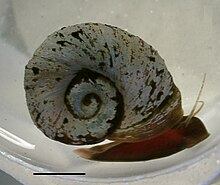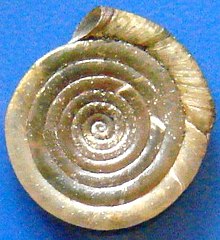扁蜷科
| 当前條目的内容正在依照其他语言维基百科的内容进行翻译。(2017年4月18日) 如果您熟知條目内容并擅长翻译,欢迎协助改善或校对此條目,长期闲置的非中文内容可能会被移除。 |
扁蜷科 Planorbidae | ||||||||||||
|---|---|---|---|---|---|---|---|---|---|---|---|---|
 A live individual of Indoplanorbis exustus | ||||||||||||
科學分類 | ||||||||||||
| ||||||||||||
多樣性 | ||||||||||||
| 約250種淡水物種 | ||||||||||||
屬 | ||||||||||||
見內文 |
扁蜷科(學名:Planorbidae),亦作扁卷螺科,是腹足綱之下的一個單系群支序,本科物種皆為可呼吸空氣的淡水螺[2]。原屬有肺目基眼亞目椎實螺總科,今屬異鰓類泛有肺類喜溼螺類支序[3]。
本科多個物種的外殼都是平旋壳(planispiral)[4],與一般腹足綱物種的外殼形狀不同。外殼看似是右旋,但其實是螺把殼上下顛倒來揹在身上,使左旋的外殼看起來像是右旋。
因其外形,本科物種又稱羊角螺。
由於本科物種的頭和腹足都比較細小,使得牠們頭上絲般幼的觸角顯得很細長。
目录
1 分類
1.1 2005年分類
1.2 2007年本科部分物種的分類
1.3 Cladogram
1.4 屬
2 Shell description
2.1 Sinistral shells
3 血色素
4 習性
5 Geological history
6 Geographical distribution
7 參看
8 參考文獻
9 外部連結
分類
對於部份分類元來說,是否應該歸入扁蜷科仍有爭議。這對於淡水帽貝Ferrissia跟Ancylus這兩個屬來說由其合適。這些屬有時會被歸入椎实螺科(Lymnaeidae Rafinesque, 1815);另外亦有文獻把上述兩個屬放進各自的一個科裡。然而,在布歇特和洛克羅伊的腹足類分類 (2005年)[2]的分類,這些屬被歸為扁蜷亞科(Planorbinae)之下的Ancylini族。以下將詳述這個分類的具體內容。
2005年分類
根據布歇特和洛克羅伊的腹足類分類 (2005年),本科包括下列各個亞科[2]:
扁蜷亞科 Planorbinae Rafinesque, 1815
扁蜷族 Planorbini Rafinesque, 1815[5]:synonyms: Choanomphalinae P. Fisher & Crosse, 1880; Orygoceratidae Brusina, 1882- tribe Ancylini Rafinesque, 1815 - synonym: Pseudancylinae Walker, 1923 (inv.)
- tribe Biomphalariini H. Watson, 1954 - synonyms: Acrorbini Starobogatov, 1958; Drepanothrematini Zilch, 1959; Taphiinae Harry & Hubendick, 1964
- tribe Planorbulini Pilsbry, 1934
- tribe Segmentinini F.C. Baker, 1945
- subfamily Bulininae P. Fischer & Crosse, 1880
- tribe Bulinini P. Fischer & Crosse, 1880 - synonyms: Laevapicinae Hannibal, 1912; Isidorinae Annandale, 1922; Gundlachiinae Starobogatov, 1967
- tribe Coretini Gray, 1847 - synonyms: Pompholicinae Dall, 1866 (inv.); Camptoceratinae Dall, 1870; Megasystrophinae Tryon, 1871 (inv.); Pompholycodeinae Lindholm, 1927; Helisomatinae F. C. Baker, 1928; Bayardellini Starobogatov & Prozorova, 1990; Planorbariini Starobogatov, 1990
- tribe Miratestini P. & F. Sarasin, 1897 - synonyms: Ferrissiinae Walker, 1917; Ancylastrinae Walker, 1923; Protancylinae Walker, 1923; Physastrinae Starobogatov, 1958; Ameriannini Zilch, 1959; Patelloplanorbidae Franc, 1968
- tribe Plesiophysini Bequaert & Clench, 1939
- subfamily Neoplanorbinae Hannibal, 1912 - synonym: Payettiinae Dall, 1924
- subfamily Rhodacmeinae Walker, 1917
2007年本科部分物種的分類
Albrecht等(2007)[5]分析過本科部分物種,based on sequences of mitochondrial 18S ribosomal DNA and cytochrome-c oxidase I (COI) genes, and on the basis of the results, they rearranged the taxonomy like this:
"A-clade" sensu Albrecht et al. (2007)[5]
Burnupia Walker, 1912
Tribus Bulinini
Bulinus O. F. Müller, 1781
Indoplanorbis Annandale, 1921
Tribus Ancylini Rafinesque-Schmaltz, 1815
Ancylus O. F. Müller, 1774- Ferrissia Walker, 1903
Gundlachia Pfeiffer, 1849
Laevapex Walker, 1903
Hebetancylus Pilsbry, 1914
"B-clade" sensu Albrecht et al. (2007)[5]
Glyptophysa Crosse, 1872
Protancylus Sarasin, 1897
Kessneria Walker & Ponder 2001
Leichhardtia Walker, 1988
Tribus Camptoceratini
Planorbarius Duméril 1806
扁蜷族 Planorbini
多旋螺屬 Anisus Studer, 1820
Bathyomphalus Charpentier, 1837
旋螺屬 Gyraulus Charpentier, 1837
Choanomphalus Gerstfeldt, 1859
扁蜷屬 Planorbis O. F. Müller, 1774
Tribus Segmentinini
Segmentina Fleming, 1818
Hippeutis Charpentier, 1837
类扁蜷属 Polypylis Pilsbry, 1906
"C-Clade" sensu Albrecht et al. (2007)[5]
Biomphalaria Preston, 1910
Menetus H. & A. Adams, 1855
Planorbella Haldeman, 1843
Planorbula Haldeman, 1843
Cladogram
The following is a cladogram that shows the phylogenic relationships within the Planorbidae according to Albrecht 2007:[5]
|
||||||||||||||||||||||||||||||||||||||||||||||||||||||||||||||||||||||||||||||||||||||||||||||||||||||||||||||||||||||||||||||||||||||||
屬
本科的模式屬是 Planorbis Müller。以下列出主要根據布歇特及其他人(2005)的分類[2],因為Albrecht (2007)的分類並未整全的包括本科所有的屬。至於每個屬的亞屬則依照 Glöer (2002) 的文獻[6]。以下綜合三份文獻的結果:

View of the sunken spire of the shell of Anisus septemgyratus
扁蜷亞科 Planorbinae Rafinesque, 1815
- ?
多旋螺屬 Anisus S. Studer, 1820
- subgenus Disculifer C. Boettger, 1944
Bathyomphalus Charpentier, 1837
旋螺属 Gyraulus Charpentier, 1837
- subgenus Torquis Dall, 1905
- subgenus Lamorbis Starobogatov, 1967
- subgenus Armiger Hartmann, 1843
平扁蜷屬 Hippeutis Charpentier, 1837:又名圓扁螺屬
- tribe Ancylini Rafinesque, 1815
Ancylus O. F. Müller, 1773 - type genus of tribe Ancylini[2]
- tribe Biomphalariini H. Watson, 1954
Biomphalaria Preston, 1910 - type genus of tribe Biomphalariini[2]
Drepanotrema Crosse & P. Fischer, 1880[2]
扁卷螺族 Planorbini Rafinesque, 1815
扁卷螺屬 Planorbis Müller, 1773[2]
- tribe Planorbulini Pilsbry, 1934
Planorbula Haldeman, 1840 - type genus of tribe Planorbulini[2]
- tribe Segmentinini F.C. Baker, 1945
Segmentina Fleming, 1818 - type genus of tribe Segmentinini[2]
- ?
- subfamily Bulininae P. Fischer & Crosse, 1880
Indoplanorbis Annandale & Prashad, 1920 - contains one species Indoplanorbis exustus[7]
Planorbarius Duméril, 1806
Planorbella Haldeman, 1842
Menetus H. Adams & A. Adams, 1855
- subgenus Dilatata Clessin, 1885
- tribe Bulinini P. Fischer & Crosse, 1880
Bulinus O. F. Müller, 1781 - type genus of subfamily Bulininae[2]
Gundlachia Pfeiffer, 1849
- tribe Coretini Gray, 1847
Coretus Gray, 1847 - type genus of tribe Coretini[2]
- tribe Miratestini P. & F. Sarasin, 1897
Miratesta P. & F. Sarasin, 1897 - type genus of tribe Miratestini[2]
Amerianna Strand, 1928
Ferrissia Walker, 1903[來源請求]
Pettancyclus Iredale, 1943
- tribe Plesiophysini Bequaert & Clench, 1939
Plesiophysa P. Fischer, 1883 - type genus of tribe Plesiophysini[2]
- subfamily Neoplanorbinae Hannibal, 1912
Neoplanorbis Pilsbry, 1906 - type genus of subfamily Neoplanorbinae[2]
- subfamily Rhodacmeinae Walker, 1917
Rhodacmea Walker, 1917 - type genus of subfamily Rhodacmeinae[2]
Subfamily = ? (other genera that are not yet sorted are listed here)
Acrorbis Odhner, 1937
Africanogyrus Özdikmen & Darilmaz, 2007
- synonym: Afrogyrus Brown & Mandahl-Barth, 1973
Afroplanorbis Thiele, 1931
Amphigyra Pilsbry, 1906
Anisopsis Sandberger, 1875
Antillorbis Harry & Hubendick, 1964
Armigerus Clessin, 1884
Australorbis Pilsbry, 1934
Bayardella Burch, 1977
Berellaia Laubrière & Carez, 1880
Camptoceras Benson, 1843
Camptoceratops Wenz, 1923
Carinifex W.G. Binney, 1865
Carinogyraulis Polinski, 1929
Ceratophallus Brown & Mandahl-Barth, 1973
Choanomphalus Gerstfeldt, 1859
Culmenella Clench, 1927[8]
Fossulorbis Pilsbry, 1934
Glyptophysa Crosse, 1872
Helicorbis Benson, 1855
Helisoma Swainson, 1840
Intha Annandale, 1922
Isidorella Tate, 1896
Kessneria Walker & Ponder, 2001
Leichhardtia Walker, 1988
Lentorbis Mandahl-Barth, 1954
Macrophysa (Meek) Dall, 1870
Paraplanorbis Hanna, 1922
Patelloplanorbis Hubendick, 1957
Pecosorbis D.W. Taylor, 1985
Pentagoniostoma Branson, 1935
Perrinilla Hannibal, 1912
Physastra Tapparone-Canefri, 1883
Physopsis Krauss, 1848
Pingiella F.C. Baker, 1945
Pitharella F. Edwards, 1860
Planorbifex Pilsbry, 1935
Planorbina Haldeman, 1842
Platyphysa P. Fischer, 1883
Platytaphius Pilsbry, 1924
Polypylis Pilsbry, 1906
Promenetus F.C. Baker, 1935
Protancylus P. & F. Sarasin, 1897
Pygmanisus Iredale, 1943
Segmentorbis Mandahl-Barth, 1954
Sineancylus Gutiérrez Gregoric, 2014
Syrioplanorbis F.C. Baker, 1945
Trochorbis Benson, 1855
Vorticifex Meek in Dall, 1870
The genus Camptoceratops Wenz, 1923 is no longer considered to be a planorbid. It was recognised by Curry (1965, p. 360) as a euthecosomatous pteropod (Heterobranchia) (note by Arie W. Janssen, 092507).
The generic name Taphius H. Adams & A. Adams, 1855 is a synonym for Biomphalaria.[2]
Shell description

Apical, apertural and umbilical view of the shell of Biomphalaria tenagophila. Scale bar is 3 mm.
The shells of most species in this family are disk-like or button-like, being coiled in one plane, although several groups have shells that are more higher-spired, and some are limpet-like.
All coiled shell Planorbidae are sinistral in their shell coiling, as is proved by their internal anatomy (the respiratory and the genital orifice are situated on the left side), however the animals carry their shells with what would normally be the ventral (i.e. umbilical) surface uppermost, and because of this, the shells appear to be dextral.
Indeed, formerly planorbids were thought to have dextral shells, and so species of this family were figured as if they had dextral shells. Although it is now understood that these species are sinistral in shell coiling, disk-like Planorbid shells are often still shown in illustrations oriented as if they were dextral.
Most species of coiled planorbids have a rather thin and moderately smooth shell, although more distinct sculpture such as a keel occurs in, and is diagnostic of, certain species. In the flat, keeled species, the whorls tend to overlap.
The aperture has a sharp outer lip. A peristome can be present, but often the lip is not thickened nor reflected. Those planorbid species which have a high-spired shell may have a narrow umbilicus, but frequently this is covered by callus.
In height most species vary between 6 mm and 6 cm, however, disk-like shells are usually less than about 2 cm in maximum dimension.
Like all pulmonate aquatic snails, ramshorn shells do not have an operculum to close the shell aperture.
Sinistral shells

Planorbarius corneus. View of the sunken spire (held facing downwards in life)

Planorbarius corneus. View of the umbilicus (held uppermost in life)

白化了的扁卷螺科物種,令帶有血紅素的身體組織在身體內顯得紅紅啡啡的。
Flat-coiled planorbid gastropod shells are hard to understand in terms of their coiling and orientation. Many of the shells of species in this family are almost planispiral in coiling such that one side of the shell often looks rather like the other side, but it is important to bear in mind that nonetheless there is an umbilical side and a spire side of the shell. In addition these are in fact sinistral shells, despite the fact that the snail carries its shell as if it were a normal dextral shell. To make sense of the shell coiling, the following facts are useful:
- In life, these pond snails hold their shells upside down compared to the normal gastropod shell orientation, with the umbilicus facing upwards
- The spire of the shell is quite sunken in many species, in addition it is carried facing downwards
- The umbilicus of the shell is very wide and shallow
- In some species the umbilicus is not as deeply "dished" as the sunken spire is, so superficially it can be hard to tell one from the other
However, once it is understood that the planorbid shell is sinistral, if the shell is held with the aperture on the left and facing the observer, then the sunken spire side of the shell is uppermost. This is a convenience for understanding the shell, but is the opposite of the way the shell is actually carried in life.
The side of the shell which is in fact the spire (a sunken spire) faces down in the living animal, contrary to what is the case in almost all other shelled gastropods. Because the shell is carried "upside down" like this, the aperture of the shell is angled to face downwards also, so the aperture faces a little towards the spire, not away from it, as is usually the case in other shelled gastropods.
血色素
相對於其他的軟體動物,扁卷螺科物種的血液都含有血紅素。因此,這些動物呼吸氧氣時都較其他軟體動物來得更有效;而血紅素亦令這些動物的身體帶紅色,這尤其在白化物種身上更明顯。
習性
扁卷螺科的大多數物種都只能在淡水生活,只有少數物種能存活於鹹淡水交界。所以對於其他未能存活於鹹淡水的物種,亦令農夫可以用食鹽來清除牠們。
Geological history
Ancestors of ramshorn snails are known with certainty since the Jurassic period. Modern taxa developed since the Cretaceous.
Geographical distribution
Species in this family occur worldwide. In Northwest Europe about 20 species are known (including non-indigenous species). In this region, various extinct taxa are known to have occurred, starting in the Jurassic period.
參看
- 膀胱螺科
參考文獻
^ Rafinesque, C. S. Analyse de la Nature ou tableau de l'univers et des corps organisés. Palermo. 1815: 223 pp., page 143 (法语).
^ 2.002.012.022.032.042.052.062.072.082.092.102.112.122.132.142.152.16 Frýda, J.; Hausdorf, B.; Ponder, W.; Valdés, Á.; Warén, A. Bouchet P.; Rocroi J.-P., 编. Classification and nomenclator of gastropod families. Malacologia: International Journal of Malacology (Hackenheim, Germany / Ann Arbor, USA: ConchBooks). 2005, 47 (1-2): 397 pp. ISBN 3-925919-72-4. ISSN 0076-2997.
^ 《香港淡水貝類 - 腹足綱》. 香港自然生態論壇. 2015-02-15 [2015-04-30] (中文(繁體)).
^ planospiral什么意思及同义词. 滬江詞庫. [2016-09-30].
^ 5.05.15.25.35.45.5 Albrecht, C.; Kuhn, K.; Streit, B. A molecular phylogeny of Planorboidea (Gastropoda, Pulmonata): insights from enhanced taxon sampling. Zoologica Scripta. 2007, 36: 27–39. doi:10.1111/j.1463-6409.2006.00258.x (英语).
^ Glöer, P. Die Süßwassergastropoden Nord- und Mitteleuropas (北歐和中歐的淡水腹足類動物). Die Tierwelt Deutschlands [德國的動物] ?. Hackenheim, Germany: ConchBooks. 2002: 19–20. ISBN 3-925919-60-0 (德语).
^ Liu L et al. (2010) "The phylogeography of Indoplanorbis exustus (Gastropoda: Planorbidae) in Asia". Parasites & Vectors 3: 57. doi:10.1186/1756-3305-3-57.
^ Mollusc Specialist Group (1996). Culmenella rezvoji. In: IUCN 2010. IUCN Red List of Threatened Species. Version 2010.4. <www.iucnredlist.org>. Downloaded on 08 March 2011.
引用错误:在<references>标签中name属性为“Fischer”的参考文献没有在文中使用
引用错误:在<references>标签中name属性为“Gittenberger”的参考文献没有在文中使用
引用错误:在<references>标签中name属性为“Thiele”的参考文献没有在文中使用
引用错误:在<references>标签中name属性为“Vaught”的参考文献没有在文中使用
引用错误:在<references>标签中name属性为“Wenz”的参考文献没有在文中使用
引用错误:在
<references>标签中name属性为“Zilch”的参考文献没有在文中使用
外部連結
维基共享资源中相关的多媒体资源:扁蜷科 |
(英文) NCBI Taxonomy Browser: Planorbidae
(英文) Systema naturae 2000 (classification) - Taxon: Planorbidae
Planorbidae. Integrated Taxonomic Information System (英语).
(英文) http://mkohl1.net/Planorbidae.html
- Frank Collins Baker, The Molluscan Family Planorbidae, The University of Illinois press, Urbana, 1945
|

Comments
Post a Comment